Preparing hydrangeas for winter
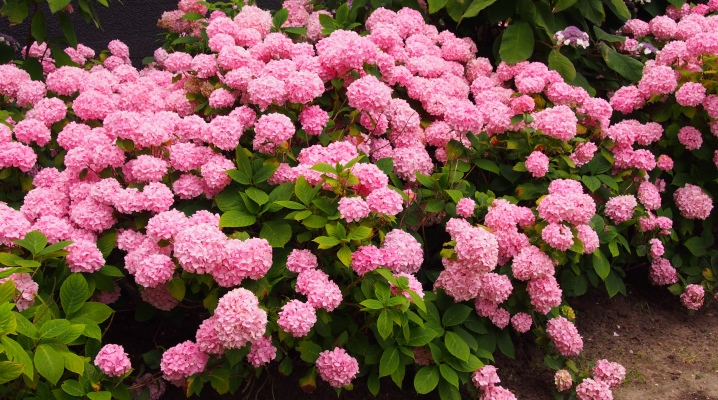
The presence of a beautiful garden pleases many summer residents and simply lovers of garden flowers and shrubs, but for the lush color and stable growth of plants, it is important to be able to properly care for them. If hydrangeas are planted on the site, then the greatest attention should be paid to their preparation for winter, otherwise it will not work to get a blooming garden in spring and summer. Timely and correct care of the plant will allow you to get strong bushes of a variety of colors in your garden.
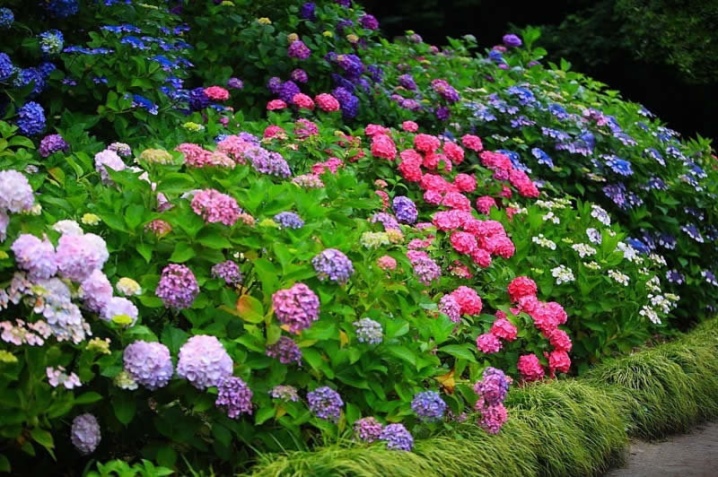
Features of wintering of different varieties
Hydrangea is a shrub that grows from 1 to 3 meters, depending on the variety. There are 2 main variants of this plant: evergreen and deciduous, each of which needs certain growing conditions. Due to the external attractiveness of the bush, the hydrangea began to be cultivated in cold regions, for which it was not initially prepared. The evergreen variety did not take root in such conditions, and the deciduous one was able to withstand the bad weather and overwinter.
In order for the hydrangea to turn green and bloom again after wintering, it is important to carry out a number of preparatory steps. Preparation for winter for a given plant will be different, depending on the variety that grows in the garden.
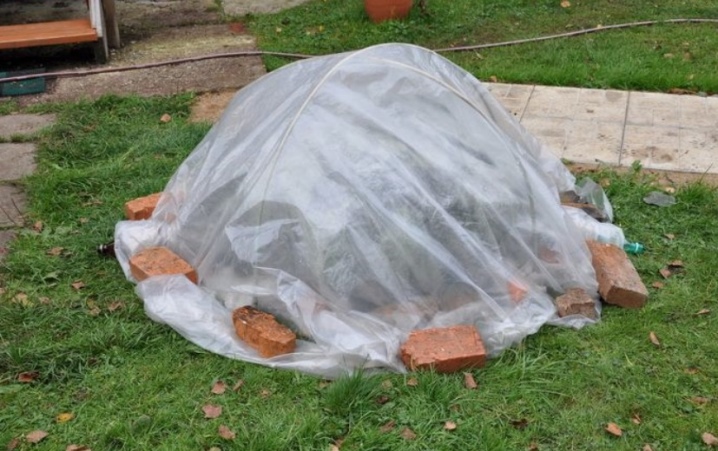
- For tree or panicle hydrangea, there is no danger from exposure to severe frosts, it winters well and departs quickly enough with the onset of the warm season.
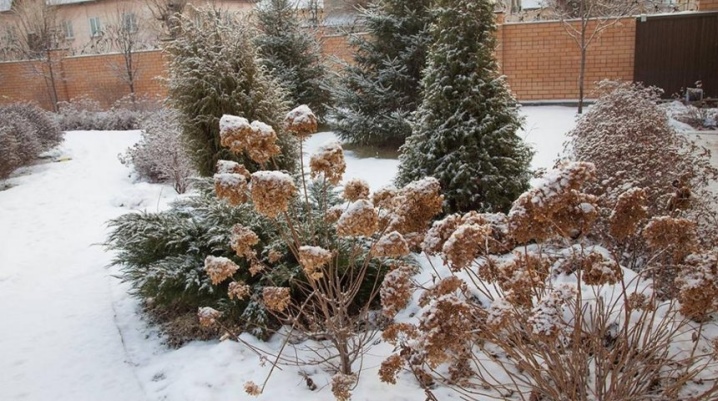
- The large-leaved variety has poor resistance to frost, and flowering after winter may not take place, as it is carried out on last year's shoots. If you do nothing with the branches, then they can freeze slightly, and the bush will stop blooming. With the right shelter, the hydrangea will become a real decoration of the garden.

- The Himalayan variety has the best winter hardiness and requires shelter only in the most extreme cases.
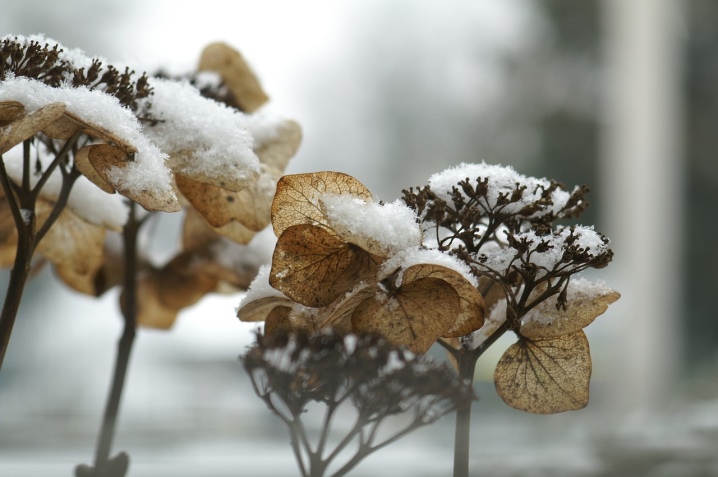
- Oak-leaved hydrangea does not tolerate frosts and winds well, therefore it is worth preparing a cozy place in the garden for it, where there will be no strong and gusty winds, and in winter it is necessary to cover it well.

- The petiolate variety is the type of plant that you do not need to cover for the winter at all, since cold temperatures will not do any harm to the culture.
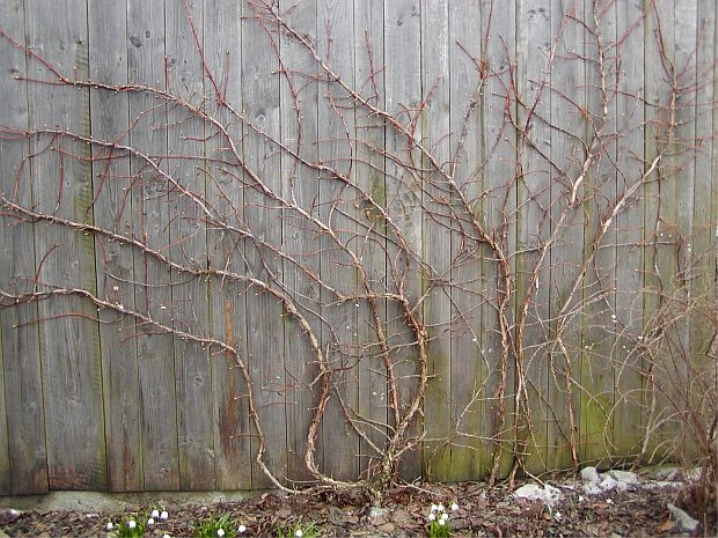
Before planting any sort of hydrangea, it is important to determine the conditions in which it will grow.
Pruning rules
The variety of types of hydrangeas allows you to choose not only those varieties that do not need to be covered or you can do this not every winter if it turned out to be warm, but at the same time use the features of pruning bushes. Some varieties are advised to prune generously, others only to prune a little. In order to properly form a bush and prepare a good basis for future flowering, it is important to understand how to properly cut a hydrangea.
The shoots of the large-leaved variety are shortened slightly, since the flowering process is carried out on last year's branches, which means that young growth does not need to be cut, since it must overwinter in order to be able to bloom normally. Treelike and panicle hydrangeas bloom on young shoots, so old ones can be cut off, which stimulates the active growth of young branches. The pruning procedure can be carried out in spring and autumn, the spring version is less convenient, since the juice is already actively spreading through the bush, which flows from the bush at the incision site, which does not happen in autumn. Each gardener chooses for himself the most favorable time for caring for the bushes, the main thing in this case will be the quality, not the pruning time.
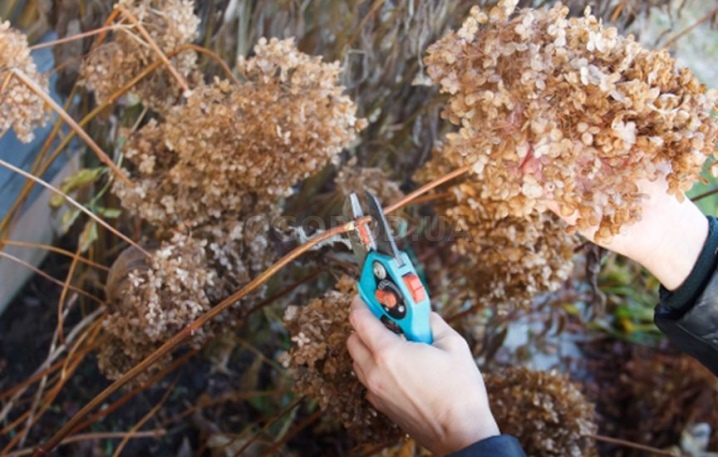
Plants blooming on the shoots of the last year should not be cut too much, in this case the pruning is exclusively cosmetic and it is done in the fall. It is recommended to cut off last year's branches before the first pair of strong buds, but old branches can be completely removed. For hydrangeas that bloom on the shoots of this year, pruning is done more thoroughly, all old and damaged branches are removed. The optimal time for this type of activity is spring, when the bush has already begun the growing season.
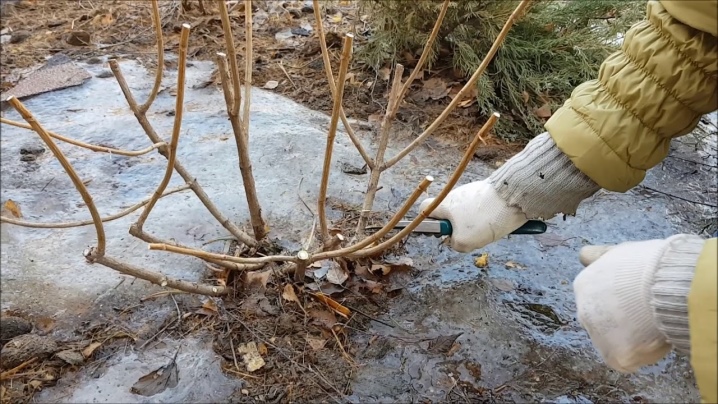
Shelter methods
To put things in order in the garden for the onset of winter, it is necessary to cover each plant in the proper way. Hydrangeas are thermophilic shrubs, so the cover layer for them should be quite large. The vines and buds, which are located at the ends of the branches, often suffer from frost, therefore the availability of good material to protect the culture is necessary. To prepare the bushes for freezing temperatures, you can choose one of two options.
- On the bush, it is necessary to cut off all thin, weak and abnormally growing shoots, in addition, completely remove the leaves from the bush itself and from the ground. Due to its large size, the bush is divided into parts based on the direction of growth of the branches, which need to be tied together and bent to the ground. The hydrangea vine is flexible and does not break, but for reliability it is better to fix it by placing it on open ground. To insulate the plant, it is recommended to put a non-woven material like lutrasil or agrospan on it, which is sprinkled on top with dry foliage from healthy trees. To prevent rain and snow from wetting such a shelter, it is necessary to put a film or burlap on top, which is covered with an old carpet or something similar. Despite the large number of layers and materials used in the shelter process, the bushes do not rot during the winter and early spring, but they are able to withstand rather low temperatures.
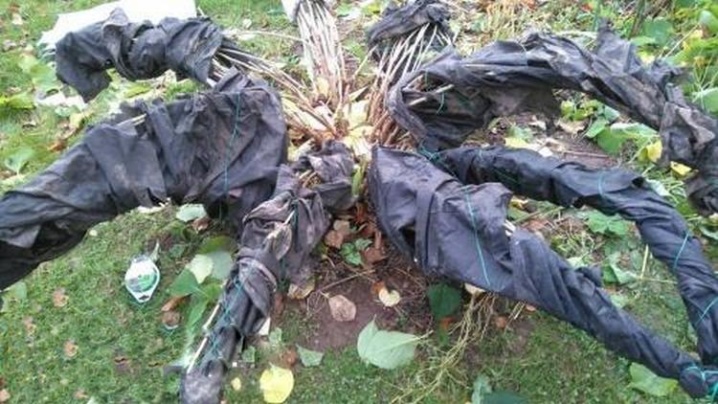
- The bush is also prepared for shelter for the winter by cutting off excess branches and collecting all the foliage, after which garden soil is poured near the root zone, and wooden boxes are placed around. The vine is laid out on boxes and fixed to them, after which the entire bush is covered with agrospan or other similar material, on top of which a film is placed. With such a shelter, it is important to open the bush in time, without rushing things, since repeated frosts will be detrimental to the plant.
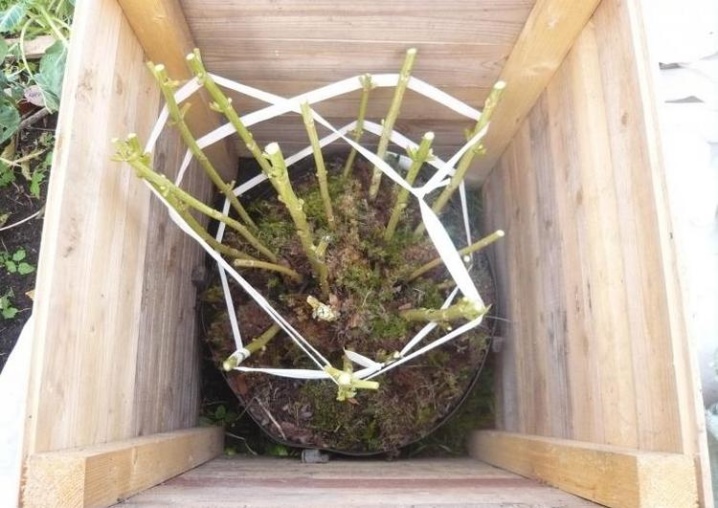
Another option for hiding hydrangeas can be considered the use of spruce branches, on which the bush vine is laid after hilling. On top, it is also necessary to lay as much spruce branches as possible, and then cover the structure with non-woven material, the edges of which are securely fixed.
If it is not possible to use spruce branches, then any covering material that fits in several layers on the prepared frame will do.
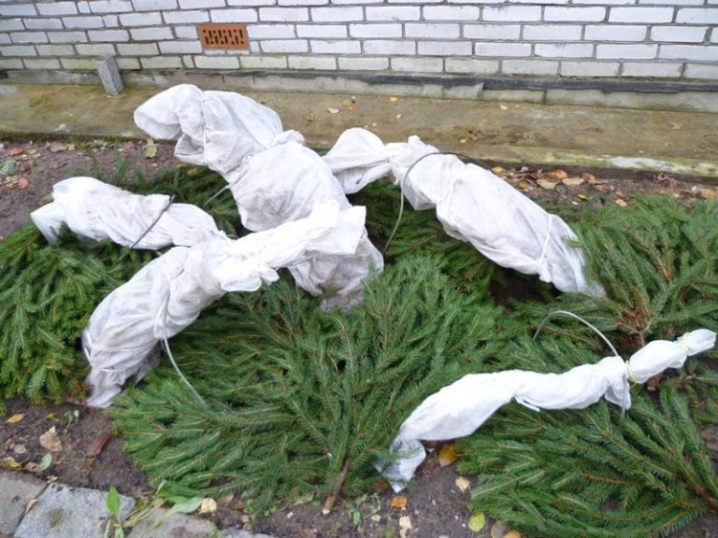
Do I need to dig it up?
Hydrangea prefers a warm climate, so it can be difficult to resist frost. For those gardeners who want to grow varieties that do not tolerate the cold, you should not leave the bushes in the garden for the winter, it is recommended to dig them up and store them in the basement. To preserve the bush in new conditions, it is important to prepare everything correctly. The basement must be well dried and treated against parasites and mold. The room temperature should not rise above the +3 mark, otherwise there is a risk of premature kidney awakening.

An important factor in the procedure for storing hydrangeas in the basement is the level of humidity in it.At high rates, the plant will begin to rot, therefore, regular ventilation through a window or open ventilation is necessary. If it is not possible to ensure a change in the air mass inside the room, you can arrange containers with quicklime, which are able to set the desired humidity level.
In winter, hydrangea should be watered infrequently and a little, moisture should ensure the viability of the root system and no more. Proper storage requires the purchase of a pot with drainage holes through which excess moisture comes out. If you can't find a pot at home, you can wrap the root system with earth in a non-woven covering material that can let air in and gradually remove water.
Storage of hydrangea bushes can also be on the windowsill in the room, if the bush is small and purchased in winter. Due to the presence of leaves and inflorescences on it, it is important to install the plant on the window, provide it with proper watering, and most importantly, additional lighting. Until the moment of planting in the ground, the bush will need to be hardened so that it takes root well in a new place. The same principle will work for plants that were stored in the basement, they also need to be prepared for new conditions, the temperature should be raised, ventilated longer and taken out for a short while outside, so that the hydrangea is completely ready for transplant by the spring warming.
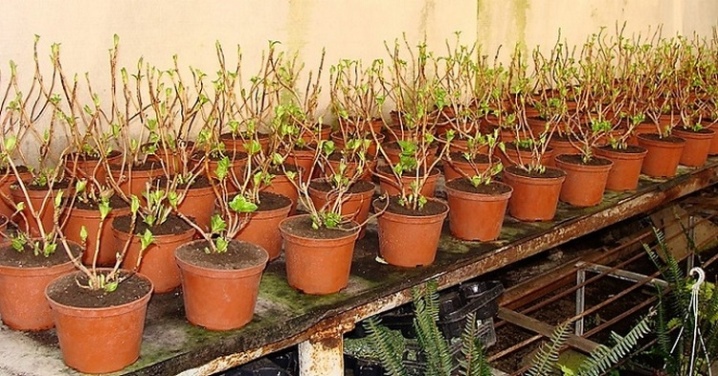
How to restore a flower in spring?
Due to the poor resistance of hydrangeas to cold weather, winter frosts can have a very negative effect on the bush, and in some cases cause its death. If the culture does not show signs of life after wintering or develops very poorly, then it is necessary to help it. Those gardeners who do not or have not been able to cover the bushes for the winter may face a number of problems.
- Hydrangea diseases - from a weakened state, the bush cannot withstand a variety of diseases, of which there are a lot in spring due to the humid and warm environmental conditions. If blackening or any other stains begin to appear on the foliage, then urgent action is needed.
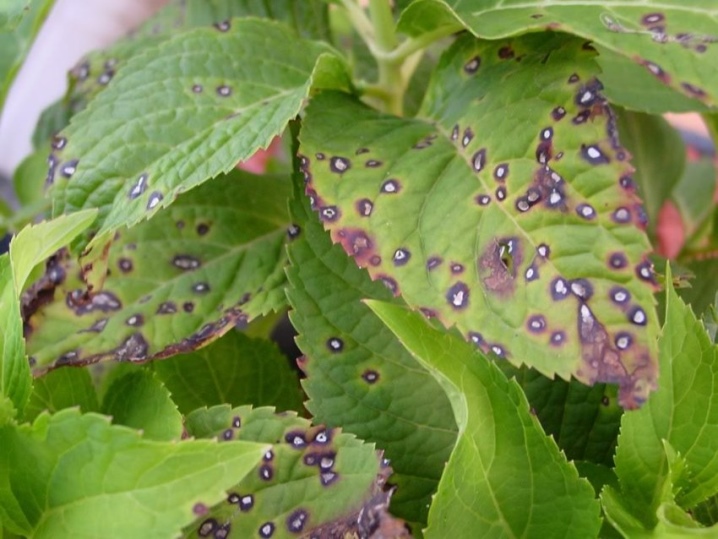
- Fungi - if the bush has been affected by fungal spores, you need to treat it with antifungal drugs, such as copper solution or Bordeaux liquid. The affected foliage must be removed immediately, and after 2 weeks the bush must be sprayed again. To prevent the problem from recurring, you should use drugs that suppress the fungus 1-2 times a month as a prophylaxis.
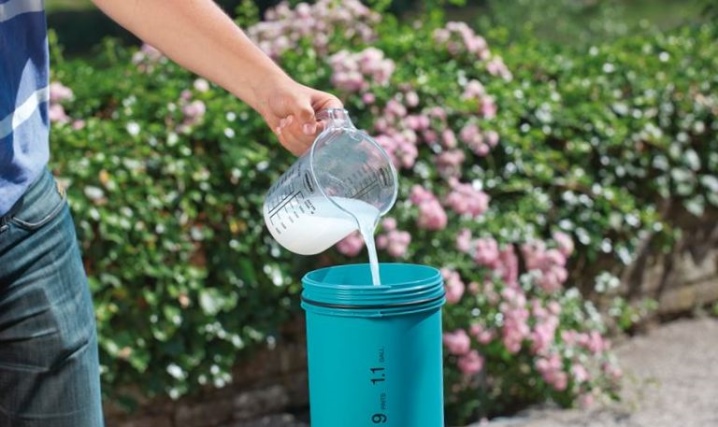
- Pests - when they appear, you need to use insecticides and look at the reaction of the bush. When pests reappear, chemicals must be used again.
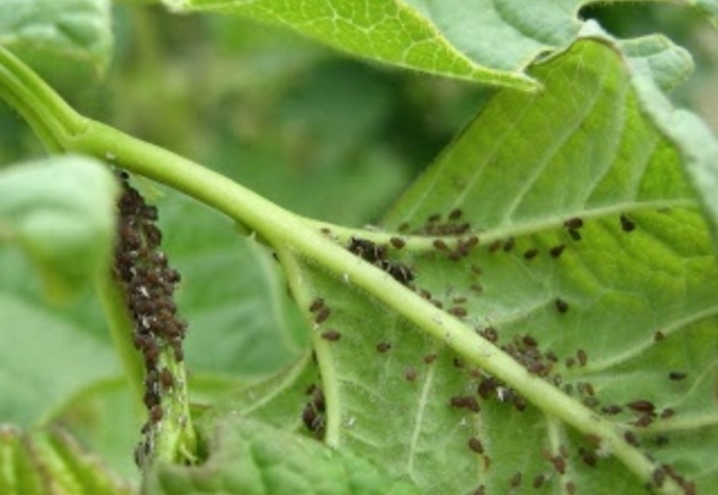
The poor development of the bush can be influenced by the alkali contained in the soil, the more there is, the worse the hydrangea feels. By adjusting the level of acidity of the soil, you can achieve the resumption of normal growth and development of the bush.
If the winter is cold, the tips of the shoots will be dry due to freezing. To help the plant regain strength, you need to remove all damaged parts, apply fertilizer and water the bush in a timely manner. With heavy damage, the hydrangea will not be able to bloom this year, but the bush will get stronger and please the next season.
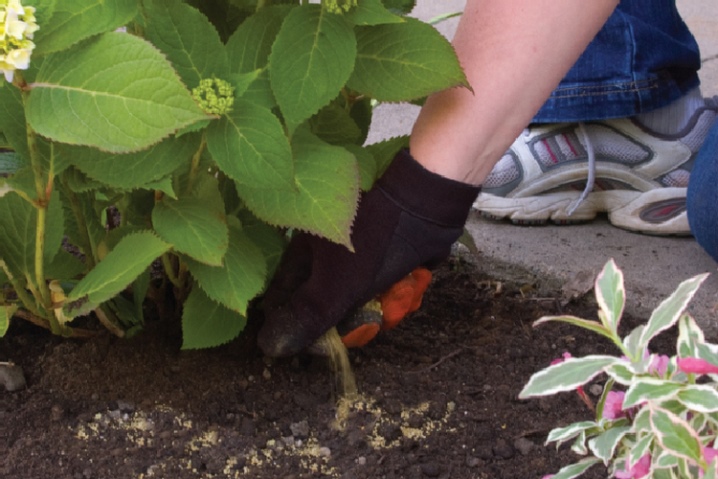
For information on how to prepare panicle hydrangea for winter, see the next video.



































































Cool article. Everything is detailed. Thanks.
The comment was sent successfully.